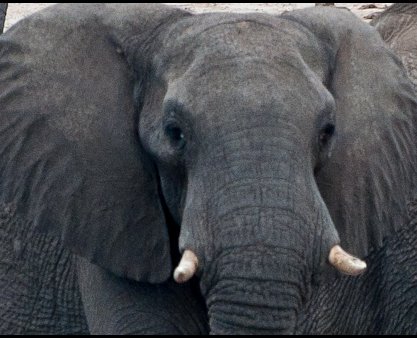After about 45 minutes of seeing nothing but green, I put away my camera and my friends and I decided to relieve our boredom by swapping stories about our favorite R-rated dating experiences. We had disintegrated into hysterics when, suddenly, the entire truck windshield filled with grey. Then, long white tusks, huge flared ears, and a swinging trunk came into a focus. A deafening trumpet blast shook us out of our stupor. We were being charged by a huge African elephant that was closing the distance between himself and our truck at breakneck speed.
The only place to go was backwards as fast as possible—until the rearview mirror filled with grey too. The second trumpet blast from behind set all of us passengers screaming at our friend behind the wheel. Turn left! Turn right! No, no there’s a huge tree! Hit the gas! Hit the gas! The T-Rex scene from Jurassic Park flashed through my mind and I envisioned a massive head flipping us end over end.
Somehow our cool headed driver managed to do a sharp 90-degree turn in reverse up over some fallen trees and into the bush off the road. All we could do was wait. The two charging elephants met in the road and turned towards the sad form of our truck, which was covered with broken branches, mud, and leaves. Apparently satisfied that we were some sort of hapless, lumbering creature and not a threat, the elephants turned away and crashed through the forest into the swamp.
We sat breathless for a few moments, trying to process what had just happened, and then burst out laughing. The elephants had put us silly, impatient humans in our place, reminding us that this was wild Africa, not some Disney experience. The driver cut the engine and we rolled down the windows. For about 20 minutes, we just listened to the sound of elephants breathing and spraying water in the swamp.
We said we wanted to see elephants, and we certainly had. This elephant encounter was like nothing I had experienced in the safari parks in Tanzania, South Africa, Namibia, and Botswana, where the elephants virtually strutted before lines of safari vehicles like models. These elephants weren’t used to seeing many people. They were, perhaps, a bit more wild than others.
Akagera National Park, one of Rwanda’s three national parks and its only savannah park, is little known among safari travelers, even those that visit Rwanda to see the mountain gorillas. Last year about 20,000 visitors came to Akagera (as compared to 200,000 estimated visitors to Serengeti National Park in Tanzania), the vast majority of which stayed on the well-traveled circuit in the park’s southern tip. If you leave the southern circuit to penetrate deeper into the park, you may well have the wilderness to yourself.
Located in eastern Rwanda, the long, thin 1,200 square-kilometer park begins in the north near the Uganda border and runs about 110 kilometers south along the Tanzania border. Originally much larger, the park lost roughly half of its area and much of its wildlife during the turbulent years after the 1994 Rwandan genocide. While you will not see the vast herds of anetlope or the diversity of predators found in some of Africa’s larger safari parks, Akagera promises some of the most spectacular savannah scenery on the continent, a diversity of mammals including Africa’s biggest and smallest antelopes, more than 500 bird species, and the chance experience the African savannah in solitude.
In my next blog, I’ll review Akagera’s highlights.







